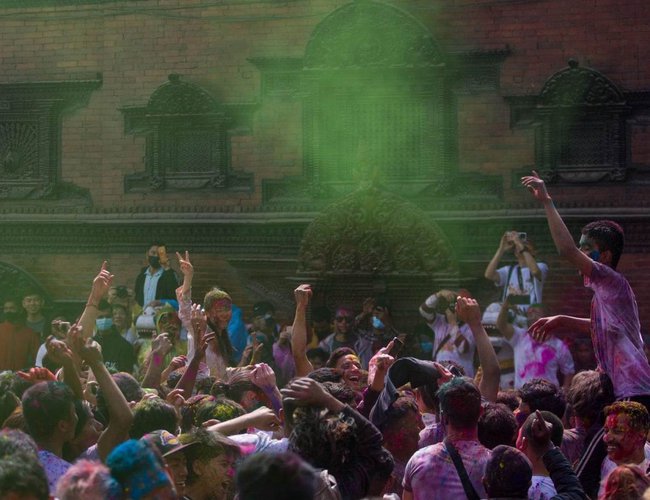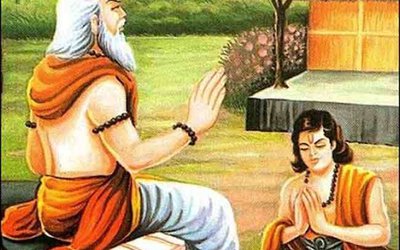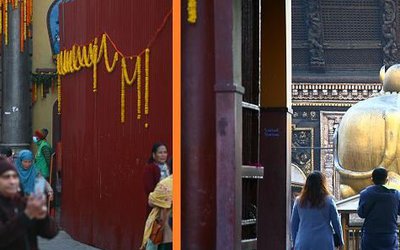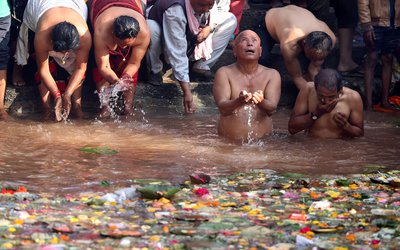
On the day of Falgun Shukla Purnima, the festival of Holi is being celebrated in Kathmandu Valley and hilly areas.
The Fagu festival brings a message of mutual harmony understanding and respect. It is traditionally celebrated today with a variety of colours and local games. The festival, which was celebrated in the Valley uncivilized way, has become more civilized lately.
Throwing lola, color and other elements against the will of the pedestrians has stopped. Spraying dirty water has not seen in the streets of the capital. The local administration ban the use of water and paint during the Fagu festival without consent of people.
Earlier, people used to through balloon filled with dirty water and sprayed it week before the festival creating an environment where women could not go out psychologically.
Fagu Purnima or Holi is a Hindu festival celebrated on a full-moon day at the end of the month of Falgun, from mid February to mid May.
Celebrated as the harbinger of good and balmy spring weather, Fagu Purnima is celebrated all over Nepal especially in the southern Terai region.
Holi will be celebrated on March 1 in the hills, while in the Terai the festival will be celebrated a day later, on March 2. Legend has it that this festival originated as celebration of the death of the Demoness Holika.
This wicked woman, who was supposed to be indestructible by fire had made several attempts to kill her nephew, Prahlad, a devout follower of Lord Vishnu. Eventually, she put the boy on her lap and set fire beneath them, thinking that he would succumb to the fire while she would escape. But instead the boy remained unharmed and Holika, to her surprise, was destroyed by the fire.
Kathmandu’s Tradition
In the Kathmandu Valley, Fagu Poornima begins on the first day with the erection of of the Chir pole about noon in front of Kumari House in Basantapur.
The erection of wooden pole heralds the spring festival every year. For a community in Ason of Kathmandu, it is an embodiment of a centuries-old tradition. The local Manandhars have been continuing the ritual every year since time immemorial, with slight modifications in between.
The community
This group of people is better known as Dhaalasiko Manandhars, who get this identity for being the residents near a dhaale (pomegranate) tree that was previously present in the area.
Every year in the month of Phalgun, the group gears up to work together to bring the Chir. The Chir is erected on Ashtami (the eighth day of the waxing moon in Phalgun) and it is taken down in the evening of the full moon (on the main Holi day) and burned in Tundikhel, to mark the end of the festival for the year.
During ancient times, Manandhars have been said to be architects, informants, and oil extractors. It is believed that King Gunakamadev had given them the responsibility to make, decorate and put up as well as down the Chir.
Today, the community has formed a registered committee as Dhaalasikwo Manandhar Sana:gu Khala to carry out the ritual.
The tradition and modifications
Manandhars claim that, during the Malla period, the Chir used to be erected at Mohan Kaji Chok of Hanumandhoka, not where it is erected these days. The Chir used to be about two to three feet high. It is believed that the tradition to place Chir near Gaddi Baithak, as we know today, was introduced by King Prithvi Narayan Shah, shares Madan Manandhar, a member of Dhaalisikwo Manandhar Sana:gu Khala.
“Once, the Chir used to be erected at four places, one at the Hanumandhoka gate, second at Mohan Chok inside the Hanumandhoka premises, another at Gaddi Baithak and the last one at Narayanhiti Palace. But after the king exited from the palace (in 2008), we only put the Chir at two places now: one at Basantapur and another at Hanumandhoka,” says Manandhar.
Nevertheless, the pole and the tradition of erecting it have remained the same during different periods, according to them. Its basic features are the same. For example, since a long ago, the Manandhars have been erecting a particular type of bamboo as the Chir. They bring a 32-foot long and six-inch thick bamboo pole from a forest near the Kathmandu Valley with the help of the Nepal Army.
The second component that has not changed is the three-tier umbrella-like structure that is placed at the top of the pole. The structure is made up of bamboo, wires and clothes. Another group of people from Damai community is responsible to cut and sew the cloth pieces for this and Dhaalasikwo Manandhars put and tie the structure on the pole and decorate the bamboo with a pitambar (yellow cloth).
The third component is a branch of dhaale (pomegranate or mayal) tree that goes on the top of the umbrella structure. The branch is brought from a forest near Guhyeshwari of Kathmandu. One part of the branch is taken back to the Guhyeshwari temple for puja after a salute by the Gurjuko Paltan. The second part is taken to the Gorakhnath temple in Mrigasthali. Another part of the branch is brought to Basantapur where the priests install it on the umbrella on the auspicious time.
Since the festival was started and promoted by the rulers in the past, the state has been giving a separate fund to the Dhaalasikwo Manandhar Sana:gu Khala to host the festival in an organised manner. Since 2010, the Kausi Tosha Khana, an office under the Financial Comptroller General Office, has been allocating Rs 48,000 per year for the festival.
Myths and messages
‘Chir’ basically translates to cloth, so the meaning of the ceremony is to put up the clothes. The story behind the tradition comes from the stories of Lord Krishna. Lord Krishna is well-known for his mischievous behaviours. Once, near the bank of Jamuna, where the gopinis were taking a bath, Krishna reached there and, using a bamboo pole, picked and put up all the clothes of the women and started throwing colours at them. So the Chir ceremony today symbolises the same with the festival of colours, informs Madan Manandhar.
Another story that popularly relates to Holi is the story of Vishnu-devotee Prahlad, a son of King Hiranyakashyapu, who was made to sit on a pyre with Holika in an attempt to kill him. However, he came out of the fire unharmed whereas Holika, who had supposedly got a blessing to be untouched by fire, died. So, this is a festival of victory of innocence over conspiracy and cruelty. Burning Chir at Tundikhel is a symbol of Holika ‘dahan’ (burning). Likewise, the victory of Lord Ram over Rawan or good over evil in Ramayana is also related to the story.
Meanwhile, another version of the story explains why they take the Chir to Tundikhel. According to the story, Keshchandra Aaju was a rich local of Itumbahal with a habit of gambling. When he lost his riches to gambling, he started being ill-treated even by his sister. He could not take it, and went to a jungle where he met the demon Gurumaapa, who tried to eat him. Aaju pleaded with the demon to leave him and, in return, promised to give him as much food as he wanted. He was set free to eat everything people leave on their roofs, but the demon started eating children too. After this, the demon was taken to Tundikhel and given the promised food. So now, with the Chir, they also take food for Gurumaapa. And after the Chir is burned, the people also play Holi with the ashes.
For the dahan, the Chir will be dragged along the Basantapur-Makkhan-Indrachok-Wotu-Mahaboudhha-Dhughabahi-Tundikhel route by the Manandhar community [with the help of Nepal Army].
The Chir dahan ritual is connected to the Marwadi community also. According to Mahabir Prasad Ghiraiya, a member of the Marwadi Sewa, his community has been facilitating the process of burning the Chir since 1953. Before that, the Manandhars were doing it, but they handed over the task to the Marwadis upon their request. He feels, “It is an opportunity for us to bond with the Newari and Nepali communities alike.”
According to Ghiraiya, the event holds a special place in the community. “Every year, it is an integral ceremony for the newlyweds of the community. They take rounds and offer alms to the fire for a prosperous married life.”
The Chir at Tundikhel is burned along with guintha (cow dung) and ghee. “As the seasons change, the fire and smoke that comes out acts as a disinfectant to kill the harmful components and insects in the environment, so it is very scientific. The heat and fire are also good for the body to warm up,” adds Ghiraiya.
The Chir is believed to be a symbol of prosperity, and unfortunately, if anything happens to it, it is believed that some disaster will follow. There is no concrete connection, yet Madan Manandhar remembers that the Chir was broken after a taxi hit the pole in the year 2015. Shortly after a few months, Nepal was struck by the massive magnitude-7.6 earthquake.
On the last day, the Chir pole is brought down, dragged to Tudikhel and burnt to cinders. The ashes are carried home by devotees as it is believed it will provide them protection against evil. In the Terai region, Holi is celebrated a day later than in Kathmandu Valley.
History of Holi
Holi is an ancient festival of Nepal and was originally known as 'Holika'. The festivals finds a detailed description in early religious works such as Jaimini's Purvamimamsa-Sutras and Kathaka-Grhya-Sutras. Historians also believe that Holi was celebrated by all Aryans but more so in the all over in the Nepal.
It is said that Holi existed several centuries before Christ. However, the meaning of the festival is believed to have changed over the years. Earlier it was a special rite performed by married women for the happiness and well-being of their families and the full moon (Raka) was worshiped.
Calculating the Day of Holi
There are two ways of reckoning a lunar month- 'purnimanta' and 'amanta'. In the former, the first day starts after the full moon; and in the latter, after the new moon. Though the amanta reckoning is more common now, the purnimanta was very much in vogue in the earlier days.
According to this purnimanta reckoning, Phalguna purnima was the last day of the year and the new year heralding the Vasanta-ritu (with spring starting from next day). Thus the full moon festival of Holika gradually became a festival of merrymaking, announcing the commencement of the spring season. This perhaps explains the other names of this festival - Vasanta-Mahotsava and Kama-Mahotsava.
Reference in Ancient Texts and Inscriptions
Besides having a detailed description in the Vedas and Puranas such as Narad Purana and Bhavishya Purana, the festival of Holi finds a mention in Jaimini Mimansa. A stone incription belonging to 300 BC found at Ramgarh in the province of Vindhya has mention of Holikotsav on it. King Harsha, too has mentioned about holikotsav in his work Ratnavali that was written during the 7th century.
The famous Muslim tourist - Ulbaruni too has mentioned about holikotsav in his historical memories. Other Muslim writers of that period have mentioned, that holikotsav were not only celebrated by the Hindus but also by the Muslims.
Reference in Ancient Paintings and Murals
The festival of Holi also finds a reference in the sculptures on walls of old temples. A 16th century panel sculpted in a temple at Hampi, capital of Vijayanagar, shows a joyous scene of Holi. The painting depicts a Prince and his Princess standing amidst maids waiting with syringes or pichkaris to drench the Royal couple in coloured water.
A 16th century Ahmednagar painting is on the theme of Vasanta Ragini - spring song or music. It shows a royal couple sitting on a grand swing, while maidens are playing music and spraying colors with pichkaris.
Legends and Mythology
Holi Purnima is also celebrated as the birthday of Shri Chaitanya Mahaprabhu (A.D. 1486-1533). However, the literal meaning of the word 'Holi' is 'burning'. There are various legends to explain the meaning of this word, most prominent of all is the legend associated with demon king Hiranyakashyap.
Hiranyakashyap wanted everybody in his kingdom to worship only him but to his great disappointment, his son, Prahlad became an ardent devotee of Lord Naarayana. Hiaranyakashyap commanded his sister, Holika to enter a blazing fire with Prahlad in her lap. Holika had a boon whereby she could enter fire without any damage on herself. However, she was not aware that the boon worked only when she enters the fire alone. As a result she paid a price for her sinister desires, while Prahlad was saved by the grace of the god for his extreme devotion. The festival, therefore, celebrates the victory of good over evil and also the triumph of devotion.
Legend of Lord Krishna is also associated with play with colors as the Lord started the tradition of play with colours by applying colour on his beloved Radha and other gopis. Gradually, the play gained popularity with the people and became a tradition.
There are also a few other legends associated with the festival - like the legend of Shiva and Kaamadeva and those of Ogress Dhundhi and Pootana. All depict triumph of good over evil - lending a philosophy to the festival.
Rituals of Holi
Rituals of the ancient festival of Holi are religiously followed every year with care and enthusiasm.
Preparations
Days before the festival people start gathering wood for the lighting of the bonfire called Holika at the major crossroads of the city. This ensures that at the time of the actual celebration a huge pile of wood is collected.
Holika Dahan Celebrations
Then on the eve of Holi, Holika Dahan takes place. Effigy of Holika, the devil minded sister of demon King Hiranyakashyap is placed in the wood and burnt. For, Holika tried to kill Hiranyakashyap's son Prahlad, an ardent devotee of Lord Naarayana. The ritual symbolises the victory of good over evil and also the triumph of a true devotee.
Children also hurl abuses at Holika and pray pranks, as if they still try to chase away Dhundhi who once troubled little ones in the Kingdom of Prithu. Some people also take embers from the fire to their homes to rekindle their own domestic fires.
Play of Colors
Next day, is of course the main day of Holi celebrations. The day is called Dhuleti and it is on this day that the actual play of colours take place. There is no tradition of holding puja and is meant for pure enjoyment.
People take extreme delight in spraying colour water on each other with pichkaris or pouring buckets and buckets of it. Singing Bollywood Holi numbers and dancing on the beat of dholak is also a part of the tradition. Amidst all this activity people relish gujiya, mathri, malpuas and other traditional Holi delicacies with great joy.
Drinks, specially thandai laced with bhang is also an intrinsic part of the Holi festivity. Bhang helps to further enhance the spirit of the occasion but if taken in excess it might dampen it also. So caution should be taken while consuming it.
Tradition in Bhaktapur
In Kathmandu, Fagu, as it is better known, begins a week earlier than the full moon night. As per traditional rituals, a tuft with colorful cloths on the top of a bamboo pole, brought from Bansghari of Bhaktapur is erected at Basantapur, the center of Kathmandu City. The erected Bamboo is called Lingo and the colorful cloths(Chir). On the evening of Fagu Purnima, the Lingo is taken down and the Chir is burnt. The event is called Chir Haran or Holika Dahan (the burning of Holika).
The installation of Lingo indicates the beginning of the weeklong celebration. Throughout the week, you’ll see kids playing with water guns and water balloons. Boys and girls throw water balloons at each other, so be careful if you are around. On the very day, people come out on streets with color powders, buckets of colored water and smear color powder at each other. Elders believe that any premonitions can be avoided if "Tika" made from the ashes of the 'Chir' is put on one's forehead or kept in the house.
- EU Ambassador To Nepal Veronique Lorenzo Paid A Courtesy Call On Rana
- Jul 27, 2024
- 139 People Died In The Disaster
- Jul 27, 2024
- Monetary Policy Eases Managing Capital Fund Stress
- Jul 27, 2024
- Weather Forecast: Chances Of Heavy Rainfall Is Likely In One Or Two Places Of Sudu Paschim And Bagmati Province
- Jul 27, 2024
- The Sentiment Of Monetary Policy Seems Focused On Increasing Eemand: FNCCI President Chandra Prasad Dhakal
- Jul 26, 2024
















